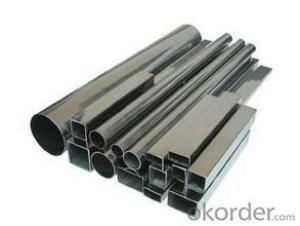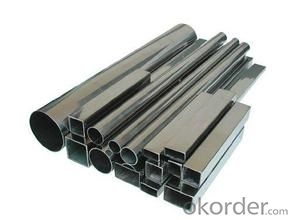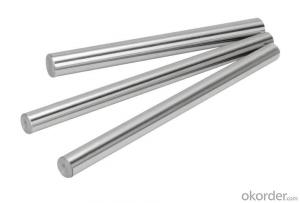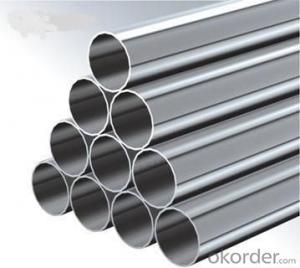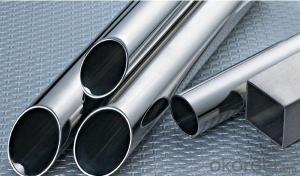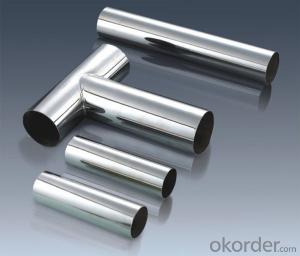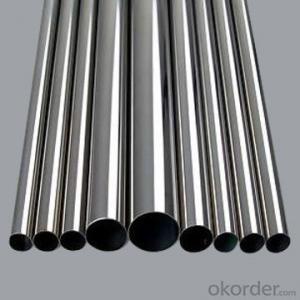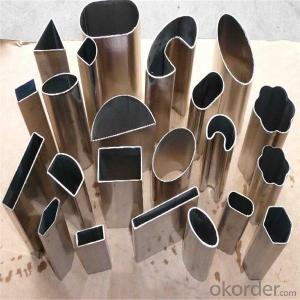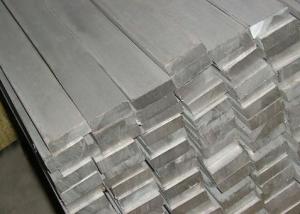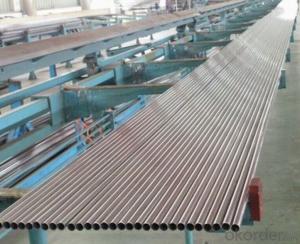stainless steel tube 304 1.4301 from okorder.com
- Loading Port:
- Tianjin
- Payment Terms:
- TT OR LC
- Min Order Qty:
- 25 m.t.
- Supply Capability:
- 1000 m.t./month
OKorder Service Pledge
Quality Product, Order Online Tracking, Timely Delivery
OKorder Financial Service
Credit Rating, Credit Services, Credit Purchasing
You Might Also Like
Quick Details
| Standard: | ASTM,DIN,EN,GB,JIS | Place of Origin: | China (Mainland) | Brand Name: | OKORDER |
| Model Number: | AD0422 6 | Type: | Welded | Steel Grade: | 300 |
| Application: | handrail,staircase,railing,weldmesh screen,door,balcony | Certification: | SGS BV ISO | Welding Line Type: | EFW |
| Thickness: | 0.3mm to 3.0mm | Outer Diameter: | 9.53mm to 254mm | Production Standard:: | ASTM A554/A312/A249/A269/A270 |
| Polish:: | Bright or Mirror,Satin, Hairline, | bending degree:: | 180 degree/ 90 Degree | contact: | OKORDER |
| product: | large diameter stainless steel pipe | Supplier: | Taizhou Hengda | packing:: | sea worthy |
Packaging & Delivery
| Packaging Detail: | Each tube in a plastic bag, then several tubes to a seaworthy woven bag with 50kg/bundle or 400kg-500kg/bundle. Or as customer's requirement. |
| Delivery Detail: | 15 days normally |
Specifications
stainless steel pipe 316L / 347 /410/ 420/430 :
1.Grade:201,202,301,304,316L,etc
2.OD:9.53-254mm,TK:0.3-3.0mm
- Q: How do you prevent leakage in stainless steel pipes?
- To prevent leakage in stainless steel pipes, there are several measures that can be taken: 1. Proper installation: Ensure that the stainless steel pipes are installed correctly by trained professionals who have expertise in working with stainless steel. This includes using appropriate fittings, connectors, and seals to ensure a tight and secure connection. 2. Regular inspections: Conduct routine inspections to identify any signs of leakage such as corrosion, cracks, or loose fittings. This allows for proactive maintenance and repairs before a major leak occurs. 3. Use high-quality materials: Choose stainless steel pipes that are made from high-grade materials and comply with industry standards. Low-quality materials or substandard manufacturing can lead to weak spots and increased risk of leakage. 4. Proper sealing: Use effective sealing methods such as gaskets, o-rings, or thread sealants to create a tight seal between pipe joints. This prevents any potential leakage points where fluids or gases can escape. 5. Pressure testing: Conduct pressure tests on the stainless steel pipes to ensure their integrity before they are put into operation. This helps identify any weaknesses or leaks that may have occurred during installation. 6. Regular maintenance: Implement a regular maintenance schedule to inspect and maintain stainless steel pipes. This includes checking for signs of corrosion, replacing worn-out seals or gaskets, and tightening fittings as necessary. 7. Avoid over-tightening: While it is important to ensure a secure connection, over-tightening fittings can lead to stress and damage to the pipe, which can result in leaks. Follow the manufacturer's guidelines for proper tightening torque. 8. Proper pipe support: Ensure that stainless steel pipes are adequately supported and secured to prevent stress or movement that can cause leaks. This includes using appropriate hangers, clamps, or brackets suitable for stainless steel pipes. By following these preventive measures, the likelihood of leakage in stainless steel pipes can be greatly reduced, ensuring the long-term integrity and reliability of the piping system.
- Q: How do stainless steel pipes compare to carbon steel pipes?
- Stainless steel pipes and carbon steel pipes are utilized extensively in various industries and applications, but they differ in composition, strength, durability, and corrosion resistance. One main distinction between stainless steel pipes and carbon steel pipes is their composition. Stainless steel pipes are produced from an iron alloy containing a minimum of 10.5% chromium, which ensures exceptional corrosion resistance. Conversely, carbon steel pipes are primarily composed of iron and carbon, with smaller quantities of other elements. In terms of strength, carbon steel pipes generally exhibit greater rigidity and strength compared to stainless steel pipes. This characteristic renders carbon steel pipes suitable for applications necessitating high pressure or heavy load-bearing capacity. Stainless steel pipes, though not as strong as carbon steel pipes, still possess commendable strength and are suitable for various applications where corrosion resistance is a priority. When it comes to corrosion resistance, stainless steel pipes outperform carbon steel pipes. The presence of chromium in stainless steel forms a protective layer, referred to as the passive film, on the surface, which prevents corrosion and rusting. This makes stainless steel pipes ideal for use in corrosive environments, such as chemical processing, marine, and offshore industries. On the other hand, carbon steel pipes are more susceptible to corrosion and require additional protective coatings or treatments to enhance their resistance. Durability is another crucial factor to consider when comparing stainless steel pipes to carbon steel pipes. Stainless steel pipes are renowned for their long lifespan and resistance to wear and tear, making them a cost-effective option in the long term. Carbon steel pipes, while durable, may necessitate more maintenance and regular inspections to prevent corrosion and degradation. To conclude, stainless steel pipes offer superior corrosion resistance, making them more suitable for use in corrosive environments. On the other hand, carbon steel pipes are stronger and more rigid, making them suitable for applications requiring high pressure. The choice between stainless steel and carbon steel pipes ultimately depends on the specific requirements of the application, including the desired level of corrosion resistance, strength, and durability.
- Q: How much is one ton of stainless steel pipe?
- First of all, to determine the use of your stainless steel pipe, and now mainly with 304 stainless steel and 316L stainless steel,304 moderate price, good rust resistance, suitable for daily home decoration.
- Q: Mechanical properties of stainless steel tubes
- Strength (tensile strength, yield strength) the strength of stainless steel is determined by various factors, but the most important and basic factor is the addition of different chemical factors, mainly metallic elements. Different types of stainless steel have different strength characteristics due to their differences in chemical composition.
- Q: Are stainless steel pipes suitable for hydraulic applications?
- Yes, stainless steel pipes are suitable for hydraulic applications. Stainless steel is known for its excellent corrosion resistance, which makes it an ideal choice for hydraulic systems that may come into contact with various fluids. Stainless steel pipes have high strength and durability, allowing them to withstand high pressure and temperature conditions commonly encountered in hydraulic systems. Additionally, stainless steel pipes offer excellent dimensional stability and can maintain their shape and integrity even under extreme operating conditions. Due to their resistance to corrosion, stainless steel pipes also provide a longer service life compared to other materials, reducing the need for frequent replacements and maintenance. Overall, stainless steel pipes are a reliable and efficient choice for hydraulic applications.
- Q: Can stainless steel pipes be used for chemical processing plants?
- Yes, stainless steel pipes can be used for chemical processing plants. Stainless steel is a popular choice for various industrial applications, including chemical processing, due to its excellent corrosion resistance properties. Chemical processing plants deal with various corrosive substances, such as acids, alkalis, and solvents, which can cause damage to ordinary steel pipes. However, stainless steel pipes are highly resistant to corrosion, making them suitable for handling aggressive chemicals and ensuring the safety and reliability of the plant. Additionally, stainless steel pipes can withstand high temperatures, pressure, and mechanical stresses, making them a durable and long-lasting choice for chemical processing plants.
- Q: Can stainless steel pipes be cold worked?
- Yes, stainless steel pipes can be cold worked. Cold working is a process that involves deforming the metal at room temperature, without the need for heating. Stainless steel, being a versatile and ductile material, can be easily cold worked to achieve desired shapes and sizes. Cold working methods such as bending, flaring, swaging, and drawing can be applied to stainless steel pipes to meet specific requirements. Cold working also enhances the strength and hardness of the stainless steel, making it suitable for various applications in industries such as construction, automotive, and manufacturing.
- Q: Are stainless steel pipes suitable for high-pressure steam applications?
- Yes, stainless steel pipes are suitable for high-pressure steam applications. Stainless steel is known for its excellent corrosion resistance, high temperature resistance, and strength, making it an ideal material for handling high-pressure steam. The pipes' ability to resist corrosion ensures that they can withstand the harsh conditions and prevent any leakage or failure. Additionally, stainless steel pipes can handle high temperatures without deforming or weakening, ensuring the safe and efficient transfer of steam. Overall, stainless steel pipes are a reliable choice for high-pressure steam applications due to their durability, corrosion resistance, and ability to withstand high temperatures.
- Q: What is the difference between 304J9 and 316J9 stainless steel pipes?
- The main difference between 304J9 and 316J9 stainless steel pipes lies in their composition and properties. 304J9 stainless steel pipes are part of the 304 series, which is a widely used austenitic stainless steel grade. This grade contains 18% chromium and 8% nickel, providing good corrosion resistance and excellent formability. It is commonly used in various industries, including construction, food processing, and pharmaceuticals. On the other hand, 316J9 stainless steel pipes belong to the 316 series, which is an upgraded version of the 304 series. It contains 16-18% chromium, 10-14% nickel, and 2-3% molybdenum. The addition of molybdenum enhances its corrosion resistance, especially in environments with chlorides or other corrosive agents. As a result, 316J9 stainless steel pipes are often used in marine applications, chemical processing, and coastal environments. In terms of mechanical properties, 316J9 stainless steel pipes generally exhibit higher tensile strength and higher yield strength compared to 304J9 stainless steel pipes. This increased strength is due to the addition of molybdenum, which improves the alloy's ability to withstand stress and deformation. Furthermore, the presence of molybdenum in 316J9 stainless steel pipes also improves their resistance to pitting and crevice corrosion, making them more suitable for aggressive environments. However, it is important to note that 316J9 stainless steel pipes may be more expensive than 304J9 stainless steel pipes due to the higher alloy content. Ultimately, the choice between 304J9 and 316J9 stainless steel pipes depends on the specific application and the level of corrosion resistance required. While 304J9 stainless steel pipes offer good general corrosion resistance, 316J9 stainless steel pipes provide superior resistance in harsher environments.
- Q: Are stainless steel pipes resistant to acidic solutions?
- Generally, stainless steel pipes exhibit resistance to acidic solutions due to the high chromium content. This chromium forms a protective layer that shields the metal from corrosion, preventing any harm caused by the acid. Nevertheless, the level of resistance can differ among various grades of stainless steel. Certain grades offer greater acid resistance compared to others. To determine the most appropriate grade for a specific application involving acidic solutions, consulting the manufacturer or a corrosion specialist is essential.
Send your message to us
stainless steel tube 304 1.4301 from okorder.com
- Loading Port:
- Tianjin
- Payment Terms:
- TT OR LC
- Min Order Qty:
- 25 m.t.
- Supply Capability:
- 1000 m.t./month
OKorder Service Pledge
Quality Product, Order Online Tracking, Timely Delivery
OKorder Financial Service
Credit Rating, Credit Services, Credit Purchasing
Similar products
Hot products
Hot Searches
Related keywords
